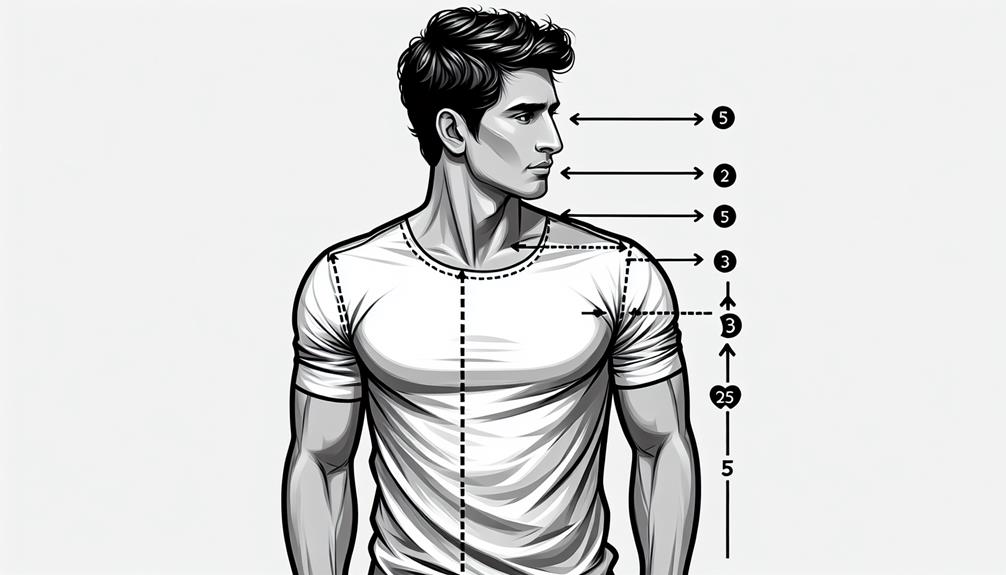I know what you might be thinking – talking about how a shirt should fit might sound overly specific or unnecessary. However, the right fit can make a world of difference in how you present yourself.
From the collar snugly hugging your neck to the sleeves hitting just at the right spot, each detail contributes to a polished and put-together look.
But how do you achieve that perfect fit without sacrificing comfort? Let's explore the key elements that make a shirt fit just right and elevate your style effortlessly.
Table of Contents
Key Takeaways
- Collar should lie flat for a polished look and frame the face elegantly.
- Shoulder width and sleeve length should be tailored for a balanced appearance.
- Aim for a comfortable fit with a slightly tapered waist and proper shirt length.
- T-shirt fit should complement physique, neither too tight nor too loose, enhancing overall appearance.
Collar Fit
When it comes to the proper fit of a shirt, making sure the collar lies flat on the chest is crucial for a polished and comfortable appearance. A well-fitted collar should embrace the neck without feeling constricting or too loose. Whether you choose a V-neck or a round neck style, the collar should rest smoothly against the chest, with no gaps or creases. For V-necks, the lowest point should be positioned above the armpits to create a flattering shape and allow for easy layering. Round necklines, conversely, offer a classic and adaptable style choice that complements various occasions.
The secret to a well-fitted collar is striking the right balance between snugness and comfort. It should frame the face elegantly and elevate the overall look of the shirt. A correctly fitting collar not only contributes to the aesthetics but also ensures that you remain comfortable throughout the day. Therefore, the next time you try on a shirt, pay close attention to how the collar rests on your chest to achieve that polished and well-coordinated appearance.
Shoulder Fit
When it comes to the fit of a shirt, the shoulders play a significant role. Proper shoulder width guarantees the shirt looks tailored to your frame, avoiding any seam misalignments.
This fit detail not only enhances the overall appearance but also allows for comfortable arm movement throughout the day.
Proper Shoulder Width
Ever wondered how to determine the proper shoulder width for a shirt that fits just right?
When it comes to shoulder fit, the key is to make sure that the shoulder seam aligns with the end of your shoulder bone. This alignment creates an ideal fit that not only looks balanced and flattering but also maintains the structural integrity of the shirt.
The fabric should smoothly drape over your shoulders without pulling or excess fabric bunching up. The sleeve length is also influenced by the shoulder width, as the seam should sit right at the edge of your shoulder for the best comfort.
Avoid Shoulder Seams
For a shirt that fits just right, it's important to make sure that the shoulder seams align perfectly with your shoulder bone. When it comes to the shoulder fit of a shirt, there are a few key things to keep in mind:
- Shoulder seams should align with the shoulder bone: Proper alignment guarantees a clean and polished look.
- Avoid shoulder seams falling off the shoulders: This can lead to an unkempt appearance and discomfort.
- Avoid shoulder seams towards the neck or upper arm: Improper placement can restrict movement and cause the shirt to look ill-fitted.
Ensuring that the shoulder seams sit correctly on your shoulders is essential for both the appearance and comfort of your shirt.
Comfortable Arm Movement
To confirm effortless movement and maximum comfort, the shoulder fit of a shirt should allow for unrestricted arm gestures and a natural range of motion. The fit of your current shoulder seam is important in preventing restrictions in arm movement, ensuring you can move freely and comfortably throughout the day.
Excess fabric in the shoulder area can lead to discomfort and limit your range of motion, so it's necessary to choose a shirt that fits well in this area. A properly fitted shoulder not only enhances comfort but also improves the overall look of the shirt, providing a tailored appearance that's both flattering and functional.
Paying attention to the shoulder fit will contribute significantly to your overall shirt-wearing experience.
Sleeve Length
When considering how a shirt should fit, the sleeve length plays an important role in achieving a balanced and proportionate appearance. Here are three key points to keep in mind about sleeve length:
- Mid-Bicep Ideal: The ideal sleeve length for a shirt ends at the mid-bicep to provide a balanced and proportionate look. This length discreetly accentuates the arms without being too short or too long, contributing to an overall polished appearance.
- Avoid Extremes: Sleeves that are too high resemble tank tops, while sleeves that reach the elbow are considered too long. Finding the right sleeve length is essential in ensuring the shirt fits well and complements your body shape.
- Enhancing Fit: Proper sleeve length can significantly improve the overall appearance and fit of a shirt. Ensuring the sleeves hit the mid-bicep not only contributes to a well-proportioned look but also adds to the overall comfort and style of the garment.
Body Width
When it comes to the body width of a shirt, it's all about finding that sweet spot between too snug and too baggy. The key is to make sure there's enough room for movement without pulling across the chest or feeling like a tent.
Aim for a fit that's comfortable, flattering, and effortlessly stylish.
Proper Shoulder Fit
Achieving the proper shoulder fit in a shirt is essential for both comfort and style. When it comes to shoulder fit, there are key elements to contemplate:
- Shoulder Seams Alignment: Make sure that the shoulder seams align with your shoulder bones for a proper fit.
- Correct Shoulder Width: The right shoulder width prevents discomfort and contributes to a well-balanced appearance.
- Comfort and Style: Proper shoulder fit is vital for overall shirt fit, impacting both comfort and the overall look of the shirt.
Appropriate Sleeve Length
Ensuring the sleeve length complements the body width is essential for achieving a well-fitted and stylish look in a shirt. When it comes to the proper t-shirt fit guide, the sleeve length plays an important role. Ideally, t-shirt sleeves should end at the mid-bicep to create a balanced appearance.
Sleeves that are too short can give off a tank top vibe, while those reaching the elbow are considered too long. A good fit means the sleeves discreetly highlight the arms without being overly tight or loose.
Shirt Length
To achieve a well-balanced look, the ideal shirt length should fall around halfway between the waist and the crotch. When it comes to shirt length, getting it right is important for a polished appearance. Here are some key points to keep in mind:
- Avoid Extremes: A shirt that hits at the waist can give the impression of being too small, while a shirt that extends past the crotch can make your legs look shorter than they are.
- Stay Around the Belt Line: Ending the shirt about 5cm below the belt line or at the middle of the fly is a good rule of thumb to prevent the 'potato-sack' appearance and ensure a well-fitted look.
- Coordinate with Bottoms: The hemline of the shirt should align nicely with the waistband of your pants or trousers for a cohesive and put-together ensemble.
Ideal T-Shirt Fit
For a well-proportioned look, nailing the ideal fit of a t-shirt involves more than just how it feels on your body. The key to the perfect t-shirt fit lies in the details: the shoulder seams should align with your shoulder bones, making certain proper alignment and a polished appearance.
Make sure the sleeves end around mid-bicep; this not only provides a flattering look but also guarantees comfort in movement. The t-shirt should fit snugly but not too tight, hugging the body without constricting it. Opt for a straight fit that doesn't hang loosely or cling excessively.
Consider your body shape when selecting a t-shirt; different cuts may complement your physique better. Lastly, pay attention to the fabric – a quality material will drape nicely and enhance the overall fit. By focusing on these aspects of t-shirt fitting – shoulders, sleeves, body shape, fit, and fabric – you can achieve a look that's both comfortable and stylish.
Proper Neckline
When considering the proper neckline for a t-shirt, it's important to choose between round or V-shaped options based on the occasion and personal preference. Here are some key points to keep in mind:
- Fabric on Either Side: The neckline should sit flat without any bulging or folding of fabric on either side. This guarantees a clean and polished look.
- Chest Hair: If you have chest hair, consider how it interacts with the neckline. A V-neck could accentuate it, while a round neck might offer more coverage.
- Sure the Sleeves: Whether opting for a V-neck or round neck, make sure the sleeves fit well. They should hug the arms comfortably without being too tight or too loose.
Sleeve Positioning
Positioning the sleeves of a shirt at the ideal length, ending mid-bicep, is important for achieving a well-fitted look. When the sleeves hit just right, it enhances the overall appearance of the shirt, discreetly accentuating the arms while providing a comfortable fit.
Sleeves that are too high can resemble a tank top style, giving off an unintended look, while sleeves reaching the elbow are considered too long, leading to extra fabric bunching up. To ensure a well-fitting t-shirt, checking the fit of the sleeves is vital. The correct sleeve length is one that hits at the midpoint of the upper arm, contributing to a polished and put-together look.
Waist and Chest Fit
Wondering how a shirt should fit around the waist and chest to achieve a balanced and comfortable look? Here are some key points to ponder:
- Tapered Waist: The waist of a well-fitting shirt should be slightly tapered, providing a defined silhouette that enhances your overall appearance.
- Pinch Test: To guarantee the right waist fit, you should be able to pinch about 1-2 inches of fabric on each side of your waist. This allows for both comfort and a tailored look.
- Chest Room: The chest area of the shirt should offer enough space for comfortable movement without excess fabric. A proper fit in this area ensures that the shirt doesn't pull or create tension, providing a sleek and polished appearance.
Achieving the ideal fit in both the waist and chest areas is critical for a shirt that combines comfort with style. Remember, the key is finding a balance that allows you to move freely while maintaining a sharp and tailored look.
Frequently Asked Questions
How Fit Should Your Shirt Be?
My shirt should fit comfortably, not too tight or loose. Shoulder seams align with my shoulders, sleeves end at mid-bicep, and torso fits well without tension lines. Shirt length ends about two inches past waistband for the perfect fit.
How Do You Know if a Shirt Fits Right?
I check if the shoulder seam aligns with my shoulder bone and make sure the sleeve length ends mid-bicep. The t-shirt should fit straight on my body, not too tight or baggy. Its length should end halfway between my waist and crotch, and the collar should lie flat without bunching.
Should Shirts Be Tight or Loose?
Shirts should fit just right, not too tight or too loose. Finding that perfect balance is key. It's about feeling comfortable and looking sharp. A fit that skims the body without being restrictive is the way to go.
How Do You Know if a Shirt Is Too Big?
If a shirt feels like I'm swimming in it, with shoulder seams past my bones, excess fabric to pinch, sleeves drowning my arms, or a hem reaching my knees, it's definitely too big.
- How to Add a Plastic Snap Closure to a Fabric Case - June 25, 2025
- Personalize Your Tech: A Guide to Customizing Fabric Phone Cases - June 25, 2025
- How to Trim and Fit Fabric Perfectly When Lining a Violin Case - June 25, 2025






